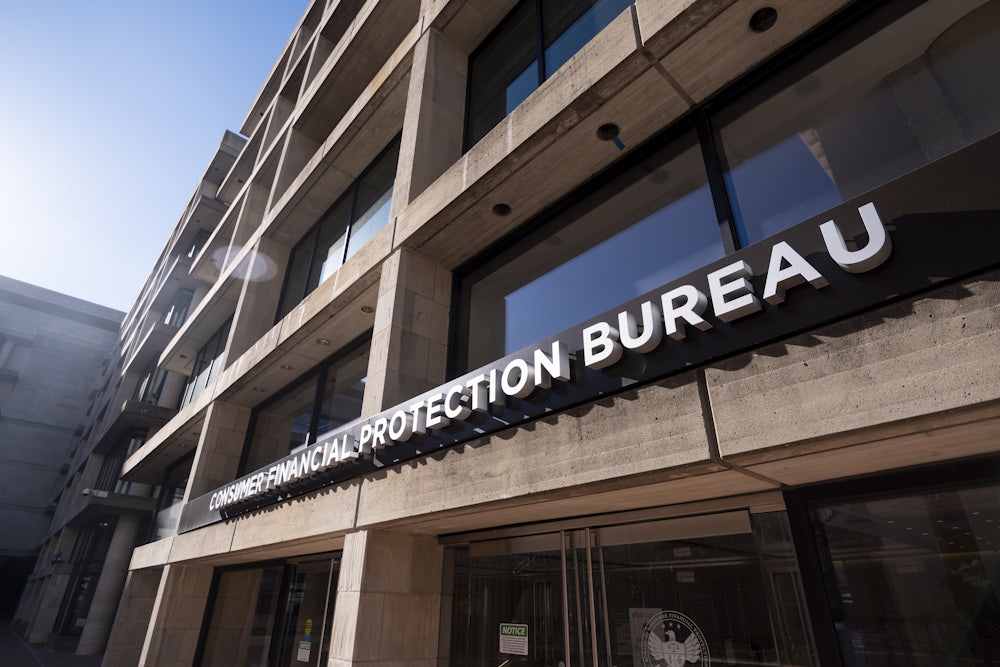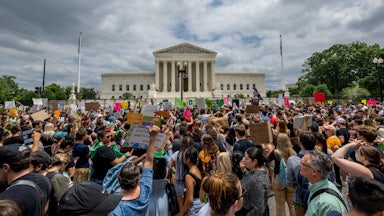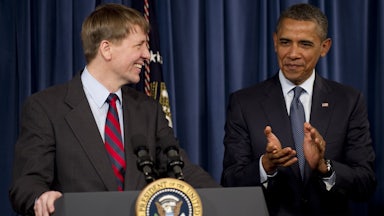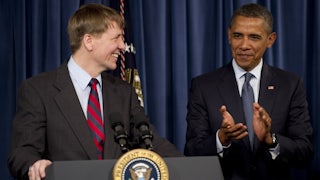The Supreme Court’s oral arguments in Consumer Financial Protection Bureau v. Community Financial Services Association of America fell along familiar lines. One side said it had the weight of text and historical practice dating back to the early republic behind its legal reasoning. The other side offered mostly policy-based arguments for its position, asking the justices to read something into the Constitution that wasn’t explicitly there. The only twist was which side was making which argument.
At issue is whether the funding structure of the Consumer Financial Protection Bureau, or CFPB, is unconstitutional. The payday-lending industry, backed by a variety of other business groups and the bulk of the conservative legal movement, says Congress violated the separation of powers by exempting the agency from Capitol Hill’s annual budget requests. The CFPB, which regulates a wide range of consumer-financial products, says its funding system is perfectly acceptable under the Constitution’s appropriations clause.
“The text of the Constitution shows that when the Framers wanted to limit Congress’s appropriations authority, they did so expressly,” Solicitor General Elizabeth Prelogar, who represents the federal government, told the justices in her opening statement. “And while the Framers restricted appropriations for the Army to two years, they applied no similar limits on appropriations for any other agency.”
Noel Francisco, who represented the lenders, offered abstractions and hypotheticals in response. He argued that allowing the CFPB’s funding structure to stand would open the door to even stranger things. “If it can do that,” he told the justices, “then it can authorize the President to spend whatever he deems reasonably necessary as long as he doesn’t exceed $10 trillion, and that would work a sea change in the separation of powers.”
The CFPB has had a tough run of luck at the high court in recent years. But based on some of the conservative justices’ questions on Tuesday, this case might turn out differently. Justice Brett Kavanaugh, who was a strong critic of the agency’s structure during his time on the D.C. Circuit Court of Appeals, appeared to agree with one of its core arguments on Tuesday—that Congress retained final control over the CFPB’s funding structure because it could change that structure at will.
When Francisco described the funding mechanism as “perpetual,” Kavanaugh interjected to disagree. “I’m having trouble with it because it implies that it’s entrenched and that a future Congress couldn’t change it,” he told the lawyer. “But Congress could change it tomorrow, and there’s nothing perpetual or permanent about this.” Francisco said the president still had too much power in this circumstance because they could veto the change, but that did not satisfy the justice. “Well, if a majority of a house of Congress said we’re not going to fund—pick your agency—unless we change the CFPB funding structure, they could do that,” he replied.
Justice Amy Coney Barrett also seemed unpersuaded by the lenders’ interpretation of the appropriations clause and how to apply it in other cases. “I think we’re all struggling to figure out, then, what’s the standard that you would use, just assuming that you’re right that there has to be something more than the $600 million,” she told Francisco, referring roughly to the CFPB’s budget last year. “How do you decide how much is too much, or how specific is specific enough?”
“It’s difficult to come up with a hard-and-fast rule that’s saying too much is too much,” Francisco said, implicitly acknowledging that he couldn’t draw a line for the justices, “which is why I do think you need to look at it from the front end and ask: Has Congress made a determination as to what the amount should be, or has it delegated that fundamental determination to the executive branch?” Kavanaugh, however, addressed that point as well by noting that Congress effectively set that amount in law and that the executive branch merely carried it out.
Tuesday’s high-level discussion about the separation of powers had much more mundane origins. The case’s origins lie in a payday-lending rule issued by the agency in 2017. The rule restricted how often payday lenders can try to automatically withdraw money from a customer’s bank account when it has insufficient funds within a certain time period. According to the CFPB, the speed of some repeated attempts made it impossible for customers to transfer money to their account quickly enough, leaving them with significant overdraft fees and the risk that their bank would close the account entirely.
The Community Financial Services Association and other payday-lending industry groups challenged the rule in court on multiple grounds. One of them was that the CFPB’s funding structure is unconstitutional for separation-of-powers reasons. Most federal agencies—but, crucially, not all of them—are funded through annual appropriations by lawmakers. When Congress created the agency 12 years ago as part of the Dodd-Frank financial reforms, however, it exempted the CFPB from that process. The agency instead draws up to a certain amount, which is statutorily fixed and adjustable for inflation, directly from the Federal Reserve System’s earnings. That cap gave the agency a $641 million budget for the 2022 fiscal year.
Congress’s power to spend money flows from the appropriations clause, which says that “no money shall be drawn from the treasury, but in consequence of appropriations made by law.” A separate provision in Article I imposes a single constraint on the appropriations process: While Congress has the power to “raise and support armies” under Article I, “no appropriation of money to that use shall be for a longer term than two years.” This two-year budget requirement for the military reflected the Founders’ fears that standing armies would be a threat to liberty and republican government, as they had been during the English Civil War in the previous century.
Beyond that, however, Congress is theoretically free to structure the expenditure of public money however it wishes. For convenience’s sake, lawmakers prefer annual appropriations for most agencies so they can better exercise their oversight powers and make adjustments when needed. A federal district court easily rejected the lenders’ challenge to the CFPB funding structure, concluding that when “a statute authorizes an agency to receive funds up to a certain cap, there is no Appropriations Clause issue.”
Then came the Fifth Circuit Court of Appeals. A three-judge panel, led by Judge Cory Wilson, concluded that the funding structure was actually unconstitutional. Wilson’s ruling depicted the CFPB, a consumer-finance watchdog agency, as a serious threat to American liberty, quoting from a Federalist Papers essay by James Madison on “elective despotism” in his opening. He reasoned that “Congress’s decision to abdicate its appropriations power to the Bureau” violated the separation of powers and brushed aside (correct) evidence that Congress has generally given budgetary autonomy to other financial regulators, including the Federal Reserve itself.
Wilson’s ruling reflected a deeper current of hostility toward the CFPB itself that runs through most of the conservative legal movement. Republican lawmakers, right-wing think tanks, and other donor-funded groups have repeatedly sought to curb or even destroy the agency’s ability to supervise consumer-facing financial products like mortgages, payday lenders, student loans, and more. As I’ve noted before, their hyperbolic claims about the CFPB’s powers and duties often describe an agency that’s been charged with protecting regular Americans from unfair financial practices and the grifters who dream them up as an existential threat to those Americans’ liberty.
Some of the justices appeared to sympathize with those concerns. The court’s more conservative members framed their barbs against the CFPB through hypotheticals, as if to say that allowing the agency to stand would invite worse things in the future. “So suppose Congress said there are a lot of outside entities that have a great interest in the work of the SEC, so we don’t think we need to appropriate any money for the SEC,” Justice Samuel Alito asked Prelogar at one point, referring to the Securities and Exchange Commission. “The SEC can simply rely on private donations and build up its own endowment, so to speak.”
Prelogar replied that it would likely be constitutional under the government’s reading of the appropriations clause, pointing to instances where Congress had set up scholarship funds that accepted private contributions. But she also noted that it would be highly unlikely for Congress to structure a regulatory agency like that because of the extremely obvious risk of regulatory capture. Besides, it’s hard to imagine that the deep-pocketed forces arrayed against the CFPB would need to do anything about a consumer-funded consumer watchdog other than outspend it.
Justice Neil Gorsuch suggested that, under the government’s reading, there was no cap to what Congress could theoretically authorize an agency to draw upon for its budget. “Your theory doesn’t turn on there being an upper limit?” he asked Prelogar. “Our theory doesn’t turn on it because of the wealth of historical evidence,” she replied. “OK, so the president could take a trillion dollars if he wished to?” Gorsuch asked.
“No, because I think that Congress itself has specified that the director is limited to the amount that’s reasonably necessary to carry out federal consumer financial law,” Prelogar explained. “But, if the president determined it was reasonably necessary to take a trillion dollars, that would satisfy your concern and, on the appropriations clause itself, has no upper-limit constraint?” Gorsuch continued. “I think that that would violate the statute, and the same theoretical possibility exists with all of the other financial regulators I’ve been discussing,” she noted.
Gorsuch continued his line of questioning by changing it to ask not only whether the appropriations clause allowed a president to take “a trillion dollars,” but also whether he could refuse to take any money at all in theory. “I don’t think the appropriations clause would be a check there,” Prelogar replied, “although, of course, Congress could then exercise its authority and its power over the purse to change the discretion that’s provided to require the president or the director of the agency to take a particular amount.”
It’s possible that Gorsuch was just testing the bounds of Prelogar’s theory, but at a certain point, the discussion with him and Alito seemed to hinge on whether Congress was simply allowed to make bad decisions. Justice Ketanji Brown Jackson suggested at one point that the real separation-of-powers concerns in this case might come not from Congress or the White House, but from the Supreme Court itself. “How do we avoid the judiciary becoming suddenly a supra-legislator, just telling the Congress, agency by agency, whether it’s a thumbs up or thumbs down from our perspective about these things?” she asked. “I mean, where are these limits in the law that prevent us from overstepping our authority?”
All the usual caveats still apply about predicting Supreme Court cases based on oral arguments, which can only offer a brief snapshot into the justices’ thinking that may not reflect their final rulings. But those who hoped the court would strike down the CFPB’s funding structure can only be disappointed by how Kavanaugh and Barrett aligned themselves in Tuesday’s session. The two justices seemed unwilling to read things into the Constitution that weren’t clearly there or deviate from the text and the historical practice—two things that the conservative legal movement once touted championing itself but seems to have forgotten in its advocacy in this case.










